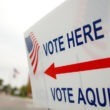For almost two years, the Ohio General Assembly has pursued a singular objective with the relentlessness that defined Melville’s most celebrated character: imposing restrictions on the state’s early voting laws. Not even when the legislators lost did they lose. When activists gathered 300,000 signatures to stay a law that imposed restrictions on absentee voting, legislators regrouped and found a way to achieve the same objective.
The voter-suppression campaign is a response to reform that followed the 2004 election, which many believe was stolen by George W. Bush.
Harvey Wasserman and Bob Fitrakis document the election fraud in their book How the GOP Stole America’s 2004 Election & Is Rigging 2008. Judges on the federal Sixth Circuit bench were almost as critical of the election as are Wasserman and Fitrakis: “At at least one polling place, voting was not completed until 4:00 a.m. on the day following election day. Long wait times caused some voters to leave their polling places without voting in order to attend school, work, or to family responsibilities or because a physical disability prevented them from standing in line,” wrote the judges, in a case filed by the League of Women Voters.
The reform followed close on the heels of the election. In 2005, Democratic Secretary of State Jennifer Brunner replaced Kenneth Blackwell, the Republican who had presided over the 2004 election. An audit commissioned by Brunner persuaded the Legislature to clean up the law that allowed (or intentionally caused) the state’s electoral system to collapse.
One measure in Brunner’s 2005 reform law was “no-fault early voting,” which allowed any registered voter to request an absentee ballot, then mail or deliver it in person—as late as 6 p.m. on the Monday before election day.
Response to the measure intended to address the lines that shut down voting in 2004 was impressive. Early voting increased from 607, 416 in 2004 to 1,717,256 in 2008. Absentee voting during the week before election day was up from 10 percent of voters in 2004 to 29.7 of voters in 2008, according to a University of Akron report, with 93,000 votes cast in the three days (Saturday through Monday) prior to the election. Two million early ballots were expected to be cast in 2012.
When Republicans won majorities in both houses of the Ohio General Assembly in 2010, they set out to dismantle reforms that made voting easier, increased turnout, and shortened long lines on election day.
Turning back the clock on reform required passing three consecutive bills, the second bill repealing the first bill and the third bill reinstating some of the restrictive measures that had been enacted in the first (repealed) bill. Legislating doesn’t get stranger, more confusing, or more dishonest than this.
Consider. Early in the 2011 legislative session, Republican majorities in both houses pushed through a bill that dismantled most of the reforms passed six years earlier. They curtailed early voting, prohibited county election boards from mailing absentee ballots or paying return postage on ballots, and eliminated the requirement that poll workers redirect voters who show up at the wrong polling place. That was House Bill 194, if you are keeping score.
Before Republican Governor John Kasich signed the bill into law, labor groups, Democratic legislators, and liberal activists began to collect signatures to refer the law to voters in November. As soon as it was evident that canvassers would gather the 231,150 votes required to put the law on the November ballot, the Republican General Assembly passed a law that repealed House Bill 194. That was House Bill 224.
After 300,000 signatures were certified and House Bill 194 (which was by then repealed) was scheduled for a November vote, the Assembly passed a third “technical corrections” bill. Changes included restrictions to no-fault early voting, in particular shutting down absentee voting on the three days prior to the Tuesday election in November. Or kind of shutting it down. The legislators technically corrected one section of the law that permitted pre-election weekend voting but failed to correct another statute that permitted it. They also unintentionally stopped uniformed military personnel from voting on the weekend before the election. That was Senate Bill 225.
To resolve the conflict in Senate Bill 225, Jon Husted, the conservative Republican who replaced Brunner as secretary of state, issued an advisory opinion. Members of the uniformed military could vote until 6 p.m. the day before the election. No one else would be allowed that privilege. So with three laws and one advisory opinion, Ohio Republicans prevented the 300,000 Ohioans who had signed petitions to stay a law that precluded voting on the weekend before the election from voting on the weekend before the election.
Husted also voted to break tie votes when two local election boards deadlocked on allowing weekend voting in their jurisdictions.
Confused? So are voters in Ohio. Yet if the legislators’ tactics are confusing, their motive is evident.
A disproportionate number of voters who took advantage of the no-fault early voting in 2008 were women, elderly people, people with lower incomes, and voters in the state’s two big metropolitan counties. The election reforms of 2004 were bringing too many Democratic voters to the polls.
In July, the Obama campaign and the Ohio Democratic Party filed suit. If the election was stolen in Ohio in 2004, perhaps it won’t be so easily stolen in 2012.
Also in this issue: See what other states have adopted similarly restrictive voting laws.






0 Comments